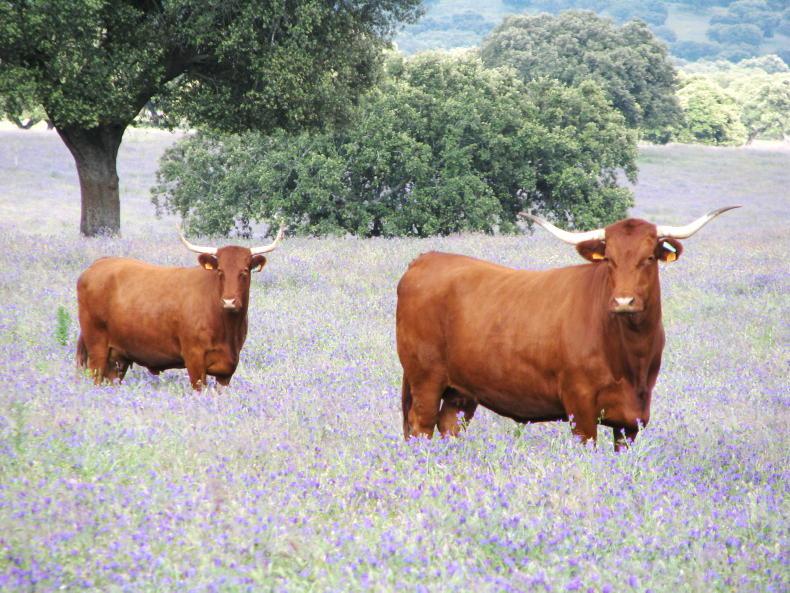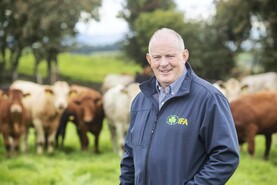What is BovINE and what do you hope to achieve?
BovINE (Beef Innovation Network Europe) is a European-funded project that’s aiming to improve the technical, economic and environmental sustainability of beef farms across Europe.
It’s doing this by identifying the current challenges European beef farmers are facing in becoming more sustainable and then finding solutions to these challenges by collecting good practices from other European beef farms and practical research innovations not yet applied on beef farms.
How will BovINE do this?
The objective of the project is to create knowledge exchange networks in nine EU member states consisting of beef farmers, farming organisations, advisers, researchers and other stakeholders. These will be connected across Europe by the overall project coordinator, Teagasc.
All nine countries have appointed a network manager to coordinate stakeholders from the beef supply chain within that country. Their aim is to identify both the challenges their beef farmers are facing and any potential solutions they might have to address the needs of the other eight countries in the project.
The project has also created a number of working groups which will focus on finding solutions in one of the four areas of sustainability, socioeconomic resilience, animal health and welfare, production efficiency and meat quality and environmental sustainability.
Each working group will bring together various experts within the European research community to look at innovations and ideas not yet tested on commercial beef farms.
Who is involved?
The nine EU countries in the project are Belgium, Estonia, France, Germany, Ireland, Italy, Poland, Portugal and Spain, which represent 75% of the suckler cow population in Europe.
What challenges and solutions have you found to date?
In 2020, the project identified several challenges surrounding the economic, social and environmental sustainability of beef farms across Europe such as tools to aid beef farmers in risk management and economic planning, innovations and technologies that can reduce mortality at calving time and solutions that reduce the leaching of nutrients into waterbodies and also those that can reduce the carbon footprint of the farm.
This year will also see the rollout of over 50 demonstrations of research innovations not yet tested on European beef farms.
Within Ireland, demonstrations will be undertaken on a new technique for reviving newborn weak/unresponsive calves, the implementation of forward purchasing and selling contracts, the use of nitrogen-fixing crops and the use of automated weighing systems and methods to predict future calving difficulty by measuring pelvic width in beef heifers.
In 2021, the project will be searching for research solutions and good practices utilised by other European beef farmers to address the following topics:
Initiatives to improve the image of beef and to break the current trend of consumption decline.Economically efficient housing systems for beef cattle.Simple tools to measure and communicate animal welfare standards on beef farms.Management, housing and environmental factors which affect animal welfare in rearing and finishing units.Managing animal nutrition and stress to improve meat quality.Methods to optimise the number of calves per cow per year in suckler beef herds.Environmental sustainability reward schemes for beef farmers.Methods to improve carbon sequestration on beef farms.Research innovations and good practices addressing these topics will be reported back to Irish farmers in a workshop co-organised by Teagasc and the IFA in November-December 2021.
Where can people access the projects findings?
The project has an online digital knowledge repository on www.hub.bovine_eu.net , where all the innovations, technologies and good practices are stored and shared among the European beef farming community.
The BovINE Knowledge Hub is free to all with an interest in beef farming and is open not only to those who wish to search for useful solutions, but also for anyone who wishes to share tips and practices.
Additionally, we are running a series of webinars over the next two years where experts from across Europe will be discussing some of the technologies and innovations the project has unearthed. Our next webinars, which are due to take place in June (14 and 28), will focus on the use of virtual fencing on beef cattle farms and on strategies to reduce methane emissions on beef farms.
How do people get involved?
If you are a beef farmer, adviser, veterinarian or any other stakeholder in the Irish beef supply chain, you can get involved by becoming a member of the Irish BovINE network. To join the network, contact kevin@agspace.ie or richard.lynch@teagasc.ie .
You can also find out more information on BovINE by visiting the projects website at www.bovineeu.net
BovINE will be hosting its next public event on the 22 June where a number of keynote speakers from the European beef industry will discuss the challenges and potential solutions available to improve the sustainability of European beef farms. Keep an eye on the projects website and social media for registration details.

Case study:
Madigan Squeeze
The Madigan squeeze is a technique that has been widely used in unresponsive foals to encourage suckling of the mare.
It involves the application of a gentle pressure to the chest area of the newborn foal through the use of a specialised binding technique in order to relax the heart rate and induce a sleep-like state.
After a short period of time, the pressure can be released and the newborn begins to demonstrate a greater willingness to rise and
suckle the mare.
The effect is thought to imitate the birthing process and the resulting hormones that are released to encourage vitality and suckling activity in the newborn foal.
Recent research on Portuguese beef farms has proven its potential to encourage slow to suckle beef calves that are showing no other obvious ailments or injuries, to rise and suckle the dam.
The BovINE project is working with Irish vets to test the feasibility of this practice on Irish beef farms and with that the development of a subsequent fact sheet for farmers.
What is BovINE and what do you hope to achieve?
BovINE (Beef Innovation Network Europe) is a European-funded project that’s aiming to improve the technical, economic and environmental sustainability of beef farms across Europe.
It’s doing this by identifying the current challenges European beef farmers are facing in becoming more sustainable and then finding solutions to these challenges by collecting good practices from other European beef farms and practical research innovations not yet applied on beef farms.
How will BovINE do this?
The objective of the project is to create knowledge exchange networks in nine EU member states consisting of beef farmers, farming organisations, advisers, researchers and other stakeholders. These will be connected across Europe by the overall project coordinator, Teagasc.
All nine countries have appointed a network manager to coordinate stakeholders from the beef supply chain within that country. Their aim is to identify both the challenges their beef farmers are facing and any potential solutions they might have to address the needs of the other eight countries in the project.
The project has also created a number of working groups which will focus on finding solutions in one of the four areas of sustainability, socioeconomic resilience, animal health and welfare, production efficiency and meat quality and environmental sustainability.
Each working group will bring together various experts within the European research community to look at innovations and ideas not yet tested on commercial beef farms.
Who is involved?
The nine EU countries in the project are Belgium, Estonia, France, Germany, Ireland, Italy, Poland, Portugal and Spain, which represent 75% of the suckler cow population in Europe.
What challenges and solutions have you found to date?
In 2020, the project identified several challenges surrounding the economic, social and environmental sustainability of beef farms across Europe such as tools to aid beef farmers in risk management and economic planning, innovations and technologies that can reduce mortality at calving time and solutions that reduce the leaching of nutrients into waterbodies and also those that can reduce the carbon footprint of the farm.
This year will also see the rollout of over 50 demonstrations of research innovations not yet tested on European beef farms.
Within Ireland, demonstrations will be undertaken on a new technique for reviving newborn weak/unresponsive calves, the implementation of forward purchasing and selling contracts, the use of nitrogen-fixing crops and the use of automated weighing systems and methods to predict future calving difficulty by measuring pelvic width in beef heifers.
In 2021, the project will be searching for research solutions and good practices utilised by other European beef farmers to address the following topics:
Initiatives to improve the image of beef and to break the current trend of consumption decline.Economically efficient housing systems for beef cattle.Simple tools to measure and communicate animal welfare standards on beef farms.Management, housing and environmental factors which affect animal welfare in rearing and finishing units.Managing animal nutrition and stress to improve meat quality.Methods to optimise the number of calves per cow per year in suckler beef herds.Environmental sustainability reward schemes for beef farmers.Methods to improve carbon sequestration on beef farms.Research innovations and good practices addressing these topics will be reported back to Irish farmers in a workshop co-organised by Teagasc and the IFA in November-December 2021.
Where can people access the projects findings?
The project has an online digital knowledge repository on www.hub.bovine_eu.net , where all the innovations, technologies and good practices are stored and shared among the European beef farming community.
The BovINE Knowledge Hub is free to all with an interest in beef farming and is open not only to those who wish to search for useful solutions, but also for anyone who wishes to share tips and practices.
Additionally, we are running a series of webinars over the next two years where experts from across Europe will be discussing some of the technologies and innovations the project has unearthed. Our next webinars, which are due to take place in June (14 and 28), will focus on the use of virtual fencing on beef cattle farms and on strategies to reduce methane emissions on beef farms.
How do people get involved?
If you are a beef farmer, adviser, veterinarian or any other stakeholder in the Irish beef supply chain, you can get involved by becoming a member of the Irish BovINE network. To join the network, contact kevin@agspace.ie or richard.lynch@teagasc.ie .
You can also find out more information on BovINE by visiting the projects website at www.bovineeu.net
BovINE will be hosting its next public event on the 22 June where a number of keynote speakers from the European beef industry will discuss the challenges and potential solutions available to improve the sustainability of European beef farms. Keep an eye on the projects website and social media for registration details.

Case study:
Madigan Squeeze
The Madigan squeeze is a technique that has been widely used in unresponsive foals to encourage suckling of the mare.
It involves the application of a gentle pressure to the chest area of the newborn foal through the use of a specialised binding technique in order to relax the heart rate and induce a sleep-like state.
After a short period of time, the pressure can be released and the newborn begins to demonstrate a greater willingness to rise and
suckle the mare.
The effect is thought to imitate the birthing process and the resulting hormones that are released to encourage vitality and suckling activity in the newborn foal.
Recent research on Portuguese beef farms has proven its potential to encourage slow to suckle beef calves that are showing no other obvious ailments or injuries, to rise and suckle the dam.
The BovINE project is working with Irish vets to test the feasibility of this practice on Irish beef farms and with that the development of a subsequent fact sheet for farmers.







 This is a subscriber-only article
This is a subscriber-only article











SHARING OPTIONS: